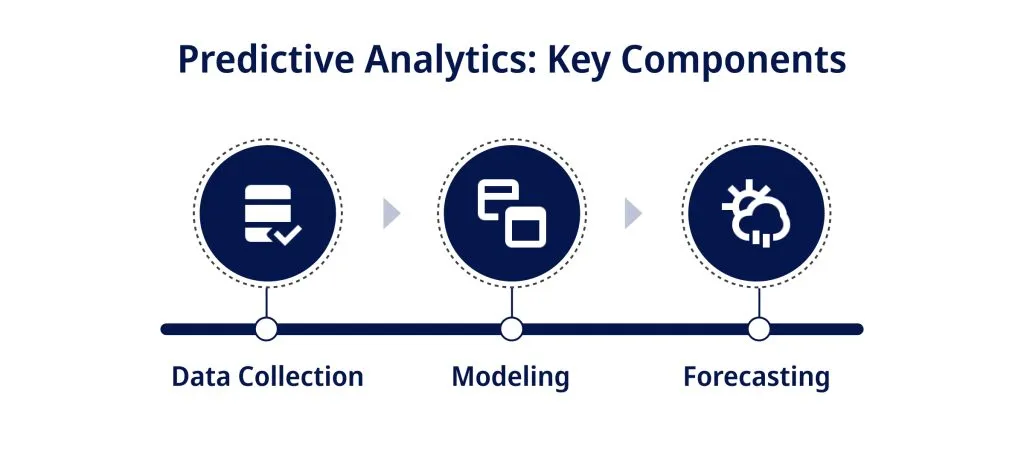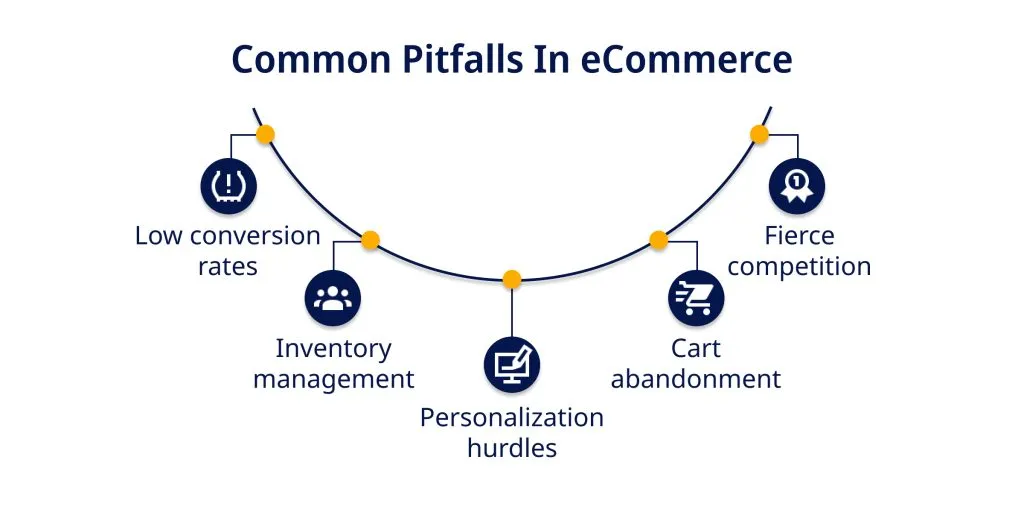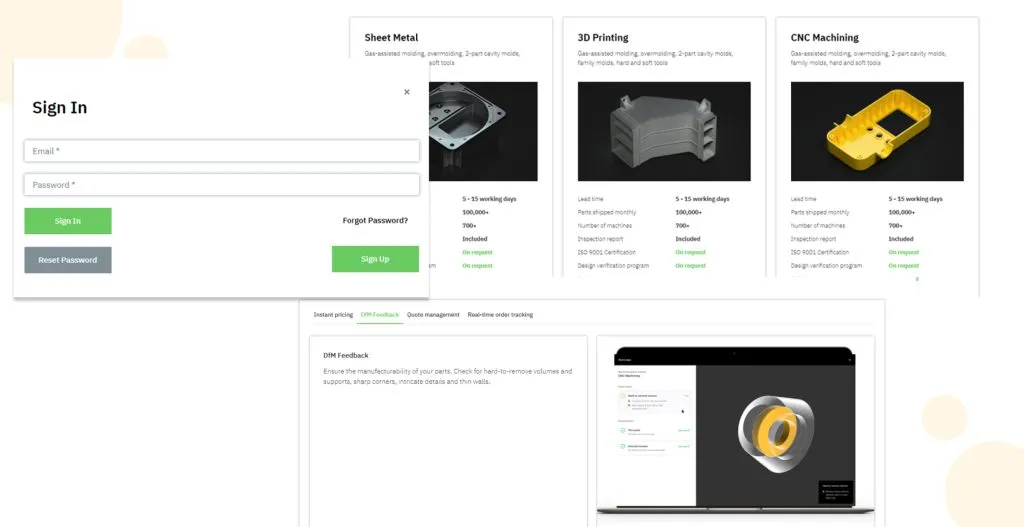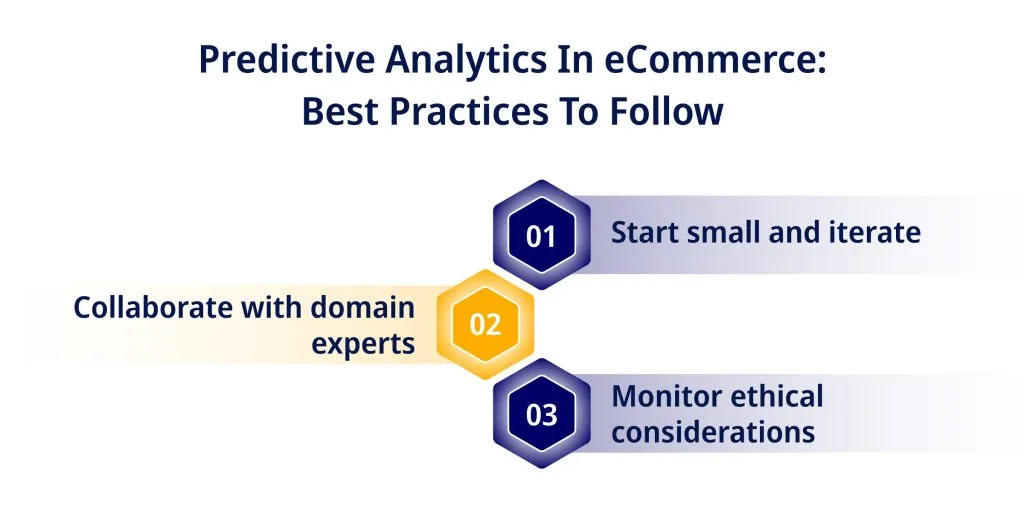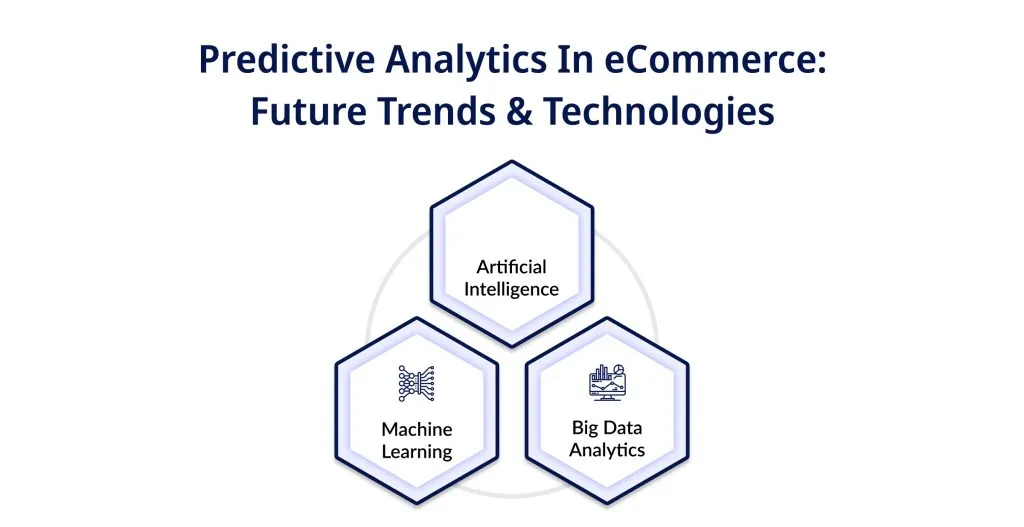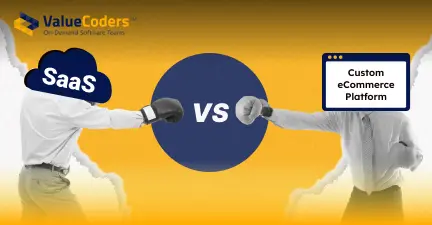Are you tired of the hit-or-miss nature of eCommerce? Do you wish there was a way to accurately predict customer behavior & optimize your online store’s performance?
If yes, then leverage the game-changing power of predictive analytics.
By harnessing the potential of predictive analytics, eCommerce businesses are unlocking valuable insights, making data-driven decisions, and ultimately elevating their online presence.
This blog post dives deeper into the world of predictive analytics, its use cases, real-world examples, and significant benefits. Read on.
Understanding Predictive Analytics in eCommerce
Predictive analytics is extracting insights from historical data to predict future events or behaviors.
Predictive analytics acts as an indispensable tool for eCommerce businesses. It empowers them to make data-driven decisions, optimize operations, and deliver exceptional customer experiences.
In eCommerce web portal development, it involves analyzing vast amounts of customer data, as given below, to anticipate customer behavior and preferences.
- Purchase history
- Browsing patterns
- Demographics
- Social media interactions
Leveraging eCommerce with predictive analytics lets you better understand your customers, identify trends, and make informed decisions to drive growth and profitability.
Key Components of Predictive Analytics
Data collection
The foundation of predictive analytics lies in collecting relevant and high-quality data. This includes:
- Customer data
- Transactional data
- Website analytics
- External data sources
The more comprehensive and accurate the data, the more reliable the predictions will be.
Modeling
Once the data is collected, it is processed & transformed into a format suitable for analysis. Various statistical and machine-learning techniques are then applied to build predictive models.
These models learn from historical patterns and relationships within the data to predict future outcomes.
Forecasting
The final step in predictive analytics adoption is forecasting. This involves using the trained models to predict future customer behavior, such as:
- Purchase likelihood
- Customer lifetime value
- Product demand
These forecasts provide valuable insights to drive strategic decision-making and optimize business operations.
Also Read: WordPress Vs Shopify: A Detailed Comparison For ECommerce Store
Benefits of eCommerce with Predictive Analytics
Personalized marketing
Predictive analytics enables businesses to deliver highly targeted & personalized marketing campaigns. By understanding customer preferences & behavior, businesses can:
- Tailor messaging
- Recommend relevant products
- Optimize marketing spend
It ultimately results in higher conversion rates & customer satisfaction.
Inventory optimization
Predictive analytics leverage eCommerce consulting services to optimize their inventory management by accurately forecasting demand.
By anticipating future demand patterns, businesses can:
- Ensure the right products are stocked in the right quantities
- Minimize stockouts
- Reduce excess inventory costs
Fraud detection & prevention
With the rise of online transactions, eCommerce web design services face the constant threat of fraud. Predictive analytics can help identify:
- Suspicious patterns
- Anomalies in real-time
Hence, it enables businesses to detect and prevent fraudulent activities, safeguarding their customers and bottom line.
Customer retention & churn prediction
By analyzing customer data, predictive analytics can identify customers at risk of churning. This allows businesses to:
- Proactively engage with these customers
- Offer personalized incentives
- Improve their overall experience
It will ultimately increase customer retention rates.
Dive into the world of predictive analytics.
Common Pain Points in eCommerce:
While B2B eCommerce solutions have revolutionized how businesses operate & customers shop, it is not without challenges.
eCommerce with Predictive Analytics has pain points that can hinder their success and growth. Let’s check out these pain points below:
Low conversion rates
Despite attracting website visitors, converting them into paying customers can be a significant challenge. Factors contributing to low conversion rates include:
- Complicated checkout processes
- Lack of trust
- Unclear product information
- Inadequate customer support
Addressing these issues is crucial for improving an eCommerce business’ overall performance and profitability.
Inventory management
Effective inventory management is essential for eCommerce. It is, however, a complex task with challenges including:
- Accurately forecasting demand
- Optimizing stock levels
- Preventing stockouts
- Managing returns
Inefficient inventory management could lead to lost sales, excess inventory costs, and
dissatisfied customers.
Predictive Analytics can help eCommerce companies meet customer demands while minimizing costs. You can hire eCommerce developers for to accomplish this task in right way.
Personalization hurdles
Achieving effective personalization can be challenging as eCommerce businesses struggle with:
- Collecting and analyzing customer data
- Segmenting their audience
- Delivering personalized experiences at scale
Overcoming these hurdles is crucial for enhancing customer engagement loyalty and driving conversions.
Cart abandonment
Cart abandonment is a significant concern for eCommerce businesses. Customers often add items to their carts but fail to complete the purchase.
Reasons for cart abandonment can include:
- Unexpected shipping costs
- Complicated checkout processes
- Concerns about payment security
- Being distracted
Reducing cart abandonment rates requires optimizing the checkout experience, offering incentives, and addressing customer concerns promptly.
Fierce competition
The eCommerce landscape is highly competitive, with numerous businesses vying for customer attention. Businesses must differentiate themselves through unique value propositions, exceptional customer experiences, and targeted marketing strategies.
Failure to effectively compete can result in lost market share and diminished growth prospects.
By leveraging predictive analytics & other advanced technologies, businesses can:
- Gain valuable insights
- Optimize operations
- Deliver exceptional customer experiences
Also Read: Pick Out The Best Open Source E-Commerce Platform For Your Project
How Predictive Analytics Addresses eCommerce Pain Points?
Predictive analytics has emerged as a powerful tool for B2C eCommerce solutions. It is offering solutions to the common pain points they face.
The potential ROI and benefits of implementing predictive analytics solutions in the eCommerce industry are significant. It leads to increased conversions, improved inventory management, enhanced personalization, reduced cart abandonment rates, and a competitive advantage in the market.
Low conversion rates
Predictive analytics can help address low conversion rates by analyzing customer data and identifying purchase intent patterns.
By leveraging machine learning algorithms, businesses can personalize the shopping experience, recommend relevant products, and optimize pricing strategies.
For example, by analyzing browsing behavior and purchase history, an eCommerce platform can offer personalized product recommendations, increasing the likelihood of conversion.
Inventory management
Predictive analytics helps in optimizing inventory management. Businesses can forecast demand more accurately by analyzing historical sales data, market trends & external factors.
This enables them to optimize stock levels, reduce stockouts, and minimize excess inventory costs. For instance, a clothing retailer can use predictive analytics to anticipate seasonal demand for specific products, ensuring the right inventory is available at the right time.
For Personalization hurdles
Predictive analytics helps overcome personalization hurdles by analyzing customer data to create detailed customer profiles.
Businesses can deliver personalized recommendations, targeted marketing campaigns, and tailored promotions by understanding individual preferences.
For example, an eCommerce with predictive analytics technology can segment customers based on browsing and purchasing history. This will help the business send personalized emails with product recommendations that align with their interests.
Cart abandonment
Predictive analytics can address cart abandonment by identifying factors that contribute to it and taking proactive measures to mitigate them.
Businesses can identify potential pain points in the checkout process by analyzing customer behavior and optimizing it for a seamless experience.
For instance, an eCommerce platform uses predictive analytics to identify customers who are likely to abandon their carts and send them personalized reminders or incentives to complete their purchases.
Fierce competition
Predictive analytics gives businesses a competitive edge by enabling them to analyze market trends, customer behavior, and competitor strategies.
By leveraging these insights, businesses can make data-driven decisions, optimize pricing, and differentiate themselves from the competition.
For example, an eCommerce business can use predictive analytics to monitor competitor pricing and adjust its own pricing strategy in real time to remain competitive.
Also Read: Transforming B2B ECommerce: A Closer Look At Leading Platform Offerings
Real-World Use Cases By ValueCoders
The following real-world predictive analytics use cases by ValueCoders demonstrate the power of predictive analytics in elevating eCommerce strategies across diverse industries.
The adoption of predictive analytics continues to grow, offering immense potential for businesses looking to elevate their eCommerce operations and stay ahead in the competitive market.
Our client, an online fashion retailer, faced the challenge of low customer engagement & conversion rates. By implementing predictive analytics, they analyzed customer data to create detailed customer profiles.
They then used these profiles to deliver personalized marketing campaigns, including tailored product recommendations and customized email promotions.
As a result, they experienced a 20% increase in customer engagement, a 15% improvement in conversion rates, and a significant boost in customer satisfaction.
The consumer electronics retailer client struggled with inventory management issues, leading to frequent stockouts and excess inventory costs.
By leveraging predictive analytics, they analyzed historical sales data, market trends & external factors to forecast demand accurately. This enabled them to optimize stock levels, reduce stockouts by 30%, and decrease excess inventory costs by 25%.
Additionally, they improved customer satisfaction by ensuring the availability of popular products.
eCommerce Portal For Fabrication Machines
Our home goods retailer’s client struggled with inaccurate demand forecasting, leading to frequent stockouts and missed sales opportunities.
By leveraging use cases of Predictive Analytics, they analyzed historical sales data, weather patterns, and promotional activities to forecast demand accurately. This enabled them to optimize inventory levels, reduce stockouts by 35%, and increase sales revenue by 20%.
They also improved customer satisfaction by ensuring product availability during peak demand periods.
Learn from real-world ecommerce success stories
Adoption Insights & Best Practices
Embracing predictive analytics as a strategic tool enables businesses to make data-driven decisions, optimize operations, and deliver exceptional customer experiences in the dynamic and competitive eCommerce landscape.
Adopting predictive analytics in eCommerce holds immense potential for businesses to elevate their strategies and achieve remarkable outcomes.
Following the adoption insights and best practices below, businesses can successfully incorporate predictive analytics into their eCommerce operations.
Have a look at the Insights into its adoption:
Understand your business objectives: Before adopting predictive analytics, it is crucial to identify the specific business objectives you want to achieve.
Whether improving conversion rates, optimizing inventory management, or enhancing personalization, aligning predictive analytics with your goals will help drive successful adoption.
Start with a pilot project: To mitigate risks and gain insights into the effectiveness of predictive analytics, consider starting with a pilot project.
Select a specific pain point or use case and implement predictive analytics on a smaller scale. This allows you to assess its impact, refine your approach, and build confidence before scaling up.
Foster a data-driven culture: Successful adoption of predictive analytics requires a data-driven culture within the organization.
Encourage cross-functional collaboration, promote data literacy, and invest in infrastructure and analytics capabilities. This ensures that decision-making is based on insights derived from predictive analytics.
Incorporating Predictive Analytics:
Ensure data quality: High-quality data is essential for accurate predictions. Cleanse and preprocess your data, addressing missing values, outliers, and inconsistencies.
Invest in data governance practices to maintain data integrity and establish data collection processes that capture relevant and reliable information.
Select appropriate models: Choose predictive analytics models that align with your business objectives and data characteristics. Consider factors such as scalability, interpretability, and computational requirements.
Popular models include:
- Regression analysis
- Decision trees
- Random forests
- Neural networks
Experiment with different models to best fit your specific use cases.
Ongoing optimization: Predictive analytics is not a one-time implementation, as it requires ongoing optimization, continuous monitoring, and evaluation of the performance of your predictive models. Incorporate new data, refine algorithms, and update models as needed.
Regularly assess the accuracy and relevance of predictions to ensure they remain aligned with changing business dynamics.
Best Practices To Follow:
Start small and iterate: Begin with a focused approach, targeting specific pain points or use cases. This allows for easier implementation, quicker results, and the ability to iterate and refine your predictive analytics strategy based on feedback and insights gained.
Collaborate with domain experts: Involve domain experts from relevant departments, such as marketing, operations, and finance, in adopting predictive analytics. Their expertise and insights can help refine models, validate predictions, and ensure alignment with business goals.
Monitor ethical considerations: As predictive analytics involve customer data, it is crucial to prioritize privacy and ethical considerations. Adhere to data protection regulations, obtain necessary consent & implement robust security measures to safeguard customer information.
Future Trends & Emerging Technologies
Predictive analytics, powered by emerging technologies like machine learning, AI, and big data analytics, is transforming the eCommerce industry.
Staying ahead of these future trends and emerging technologies is crucial for businesses to maintain a competitive edge in the ever-evolving eCommerce landscape.
The Evolving Landscape of Predictive Analytics in eCommerce
Traditionally, businesses relied on historical data to make informed decisions. However, with the advent of advanced machine learning algorithms and AI, predictive analytics has become more accurate and efficient.
Today, businesses can leverage predictive analytics to forecast customer demand, optimize pricing strategies, personalize marketing campaigns, and enhance the overall customer experience.
Harness the power of predictive analytics for your busines
Emerging Technologies Shaping the Future of eCommerce
Machine Learning
Machine learning algorithms enable businesses to analyze large amounts of data & identify patterns, trends, and anomalies.
By leveraging machine learning, eCommerce development services help you make data-driven decisions, automate processes, and deliver personalized customer experiences.
Artificial Intelligence
AI-powered solutions can analyze customer data in real time. It enables businesses to understand customer preferences, predict future behavior, and offer personalized recommendations.
AI can also automate various aspects of eCommerce operations, viz., inventory management, supply chain optimization, and fraud detection.
Big Data Analytics
Big data analytics has become crucial for eCommerce businesses due to the exponential growth of data. Businesses can uncover valuable insights, identify market trends, and optimize their operations by analyzing large datasets.
Big data analytics lets businesses personalize customer experiences, improve inventory management, and enhance supply chain efficiency.
By leveraging predictive analytics, businesses can anticipate customer needs, optimize pricing strategies, and deliver personalized experiences. This ultimately leads to:
- Increased customer satisfaction
- Improved conversion rates
- Higher revenue
Moreover, businesses that adopt predictive analytics early on can establish themselves as industry leaders and gain a loyal customer base.
Conclusion
So far, we have seen that predictive analytics has emerged as a game-changer in eCommerce. It is revolutionizing the way modern businesses operate & interact with their customers.
By harnessing the power of data & advanced algorithms, companies can:
- Anticipate customer behavior
- Optimize inventory management
- Personalize marketing campaigns
- Enhance overall customer experience
As more businesses recognize the value of predictive analytics, its adoption is expected to soar, leading to a more efficient and customer-centric eCommerce landscape.
So, what are you waiting for?
Let’s embrace this transformative technology with our experts at ValueCoders. We have been a leading eCommerce development company in India since 2004 and have completed 4200+ projects for our clients globally.


